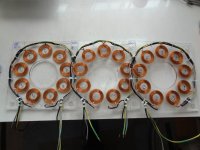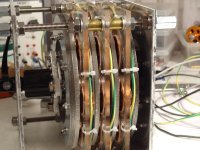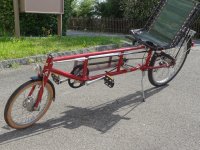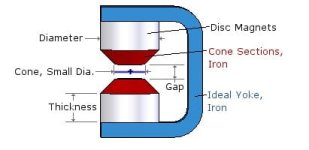Lebowski
10 MW
Regarding power numbers, I've only run it with one middle plate so it's preliminary but, I ran it at 5000 erpm (1000 rpm). This cost about
19 W of power. The voltage amplitude was 13V, current amplitude a bit less than 1 Amp. Inductance for 1 plate, 60 uH for 3 coils in series
as reported by my controller. Winding resistance should be 0.13 Ohm for 3 coils.
If the other plates are the same (same field strength), It'll need an amplitude of 40V for 1000 rpm (needing 80V battery) and have a resistance of 0.4 Ohm
per coil. 1 kW power in at 1000 rpm will then give 166 W in electrical losses and 834 W mechanical output (to be spend on mechanical losses
and propulsion). 1kW at 2000 rpm would give 42W electrical losses and 958W to be spend on the mechanical load (160V battery !).
I've run it up to around 1500 rpm at the moment, I got scared cause it was really moving ! A blown FET would have locked up the motor and
(cause of the rotor energy) thrown the thing across the room ! So I backed off... maybe I should screw it to the table.
Keep in mind, since I have a sine controller and use amplitudes instead of RMS, power = 1.5 * V_amplitude * I_amplitude , resistive power loss = 1.5 * I_amplitude^2 * R
19 W of power. The voltage amplitude was 13V, current amplitude a bit less than 1 Amp. Inductance for 1 plate, 60 uH for 3 coils in series
as reported by my controller. Winding resistance should be 0.13 Ohm for 3 coils.
If the other plates are the same (same field strength), It'll need an amplitude of 40V for 1000 rpm (needing 80V battery) and have a resistance of 0.4 Ohm
per coil. 1 kW power in at 1000 rpm will then give 166 W in electrical losses and 834 W mechanical output (to be spend on mechanical losses
and propulsion). 1kW at 2000 rpm would give 42W electrical losses and 958W to be spend on the mechanical load (160V battery !).
I've run it up to around 1500 rpm at the moment, I got scared cause it was really moving ! A blown FET would have locked up the motor and
(cause of the rotor energy) thrown the thing across the room ! So I backed off... maybe I should screw it to the table.
Keep in mind, since I have a sine controller and use amplitudes instead of RMS, power = 1.5 * V_amplitude * I_amplitude , resistive power loss = 1.5 * I_amplitude^2 * R





